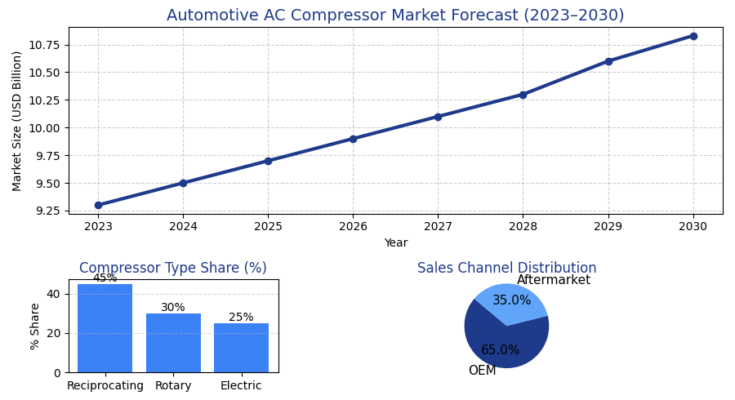The Automotive AC Compressor Market is projected to grow steadily from US $9.30 billion in 2023 to US $10.83 billion by 2030, at a compound annual growth rate (CAGR) of 2.2%. The latest comprehensive analysis highlights key drivers, market definitions, segmentation dynamics, growth opportunities, and region-wise insights into this rapidly evolving automotive component segment.
Automotive AC Compressor Market Estimation & Definition
An automotive air conditioning (AC) compressor is a central component in a vehicle’s HVAC (Heating, Ventilation, and Air Conditioning) system. It compresses refrigerant, increases pressure, and enables heat transfer, cooling the vehicle cabin. These systems are crucial for comfort, especially in regions with high ambient temperatures.
-
2023 Market Size: US $9.30 billion
-
Forecast by 2030: US $10.83 billion
-
CAGR (2024–2030): 2.2%
The market includes compressors integrated into various vehicle types, driven either by engines or electric motors, sold via OEM (original equipment manufacturer) and aftermarket channels.
Automotive AC Compressor Market Growth Drivers & Opportunities
Key Drivers
-
Increasing Vehicle Production: Rising passenger and commercial vehicle production globally continues to stimulate the demand for AC systems and their components.
-
Comfort-Centric Consumer Demand: As consumers prioritize interior comfort and climate control, automakers now integrate AC compressors even in lower-end vehicle models.
-
Climate and Environmental Changes: Hotter summers and increasing global average temperatures accelerate the need for effective air conditioning in vehicles.
-
Electric Vehicle Boom: Electrification of vehicles has increased the demand for e-compressors that function independently of internal combustion engines.
Automotive AC Compressor Market Opportunities
-
Electric Compressors: Electrically driven compressors enable HVAC systems in EVs and hybrids. Their energy efficiency, independent functionality, and adaptability offer new growth prospects.
-
Lightweight & Compact Designs: Demand for fuel efficiency and space optimization encourages manufacturers to invest in compact rotary compressors.
-
Aftermarket Expansion: The rising vehicle parc and increasing maintenance awareness contribute to consistent growth in the aftermarket segment.
-
Sustainable Cooling Technologies: Development of compressors compatible with low-GWP (Global Warming Potential) refrigerants offers new technological innovation opportunities.
Automotive AC Compressor Market Segmentation Analysis
The market is segmented by several key criteria:
-
By Design Type:
-
Reciprocating Compressors: Most common type due to their low cost and reliability. Used in both passenger and commercial vehicles.
-
Rotary Compressors: Includes scroll, vane, and screw types. Quieter and more efficient, favored in modern and luxury vehicles.
-
-
By Drive Type:
-
Conventional Compressors: Driven by the vehicle’s engine via a belt. Dominant in internal combustion engine (ICE) vehicles.
-
Electric Compressors: Driven by electric motors, essential for hybrid and fully electric vehicles. They enable HVAC operation regardless of engine status.
-
-
By Vehicle Type:
-
Passenger Vehicles: Largest contributor to global market demand.
-
Commercial Vehicles: Rapid adoption of air conditioning in trucks, buses, and vans is increasing compressor demand in this segment.
-
-
By Sales Channel:
-
OEM (Original Equipment Manufacturer): Majority of the market share as compressors are fitted during vehicle production.
-
Aftermarket: Covers replacement and repair; expanding due to the aging vehicle fleet and scheduled HVAC servicing.
-
-
By Region:
-
The report examines market activity across five major regions—North America, Europe, Asia-Pacific, Middle East & Africa, and Latin America.
-
Automotive AC compressor Market, Key Players
1. Behr Hella Service GmbH
2. Calsonic Kansei Corporation
3. Continental AG
4. Delphi Technologies
5. DENSO Corporation
6. Hanon Systems
7. Keihin Corporation
8. MAHLE GmbH
9. Michigan Automotive Compressor
10. Robert Bosch GmbH
11. SANDEN
12. Subros Limited
13. TD Automotive Compressor Georgia
14. Toyota Industries Corporation
Country-Level Analysis: USA & Germany
United States
The U.S. remains a vital market due to:
-
High Vehicle Ownership: AC systems are standard across vehicle classes.
-
OEM Dominance with Growing Aftermarket: OEM installations are robust, while the aftermarket for HVAC components, including compressors, is growing steadily with vehicle aging.
-
EV Growth: With growing EV adoption, electric compressors are gaining momentum, especially in California and other environmentally progressive states.
Germany
Germany is a key player in the European automotive landscape:
-
Strong Automotive Manufacturing Base: Home to major OEMs who are at the forefront of AC technology innovation.
-
Design Transition: Adoption of rotary and scroll compressors is increasing due to stringent noise and emission regulations.
-
Electric Mobility Push: German automakers are aggressively launching EVs, thereby increasing the use of electric compressors.
-
Aftermarket Strength: A well-regulated inspection and maintenance culture supports compressor replacements and upgrades.
Automotive AC Compressor Market Commutator Analysis
In electric AC compressors, the commutator plays a critical role, particularly in brushed motor designs, enabling current direction and torque generation. It ensures the electric motor drives the compressor effectively.
Key Points:
-
Wear and Tear: Traditional commutators suffer from brush degradation, sparking, and heat buildup, leading to shorter life spans.
-
Technological Advancements:
-
Brushless Designs: Modern electric compressors increasingly use brushless motors, eliminating commutators entirely. This reduces wear and improves efficiency.
-
Enhanced Materials: When used, commutators are made of high-grade materials to withstand high-load cycles and extreme temperatures.
-
Thermal Management: Heat-resistant designs and improved motor cooling enhance overall system reliability.
-
Sensor Integration: Smart sensors monitor current flow and motor performance, allowing predictive maintenance and minimizing system downtime.
-
The future of electric compressor design leans heavily on eliminating traditional commutators in favor of permanent magnet brushless motors, resulting in better performance, lower maintenance, and longer service life.
Automotive AC Compressor Market Conclusion
The global Automotive AC Compressor Market is entering a phase of stable yet significant transformation. Expected to grow from US $9.30 billion in 2023 to US $10.83 billion by 2030, the market is driven by climate demands, electrification, consumer comfort trends, and evolving compressor technologies.
Key Takeaways:
-
Traditional reciprocating compressors continue to dominate, but rotary variants are rapidly gaining share.
-
Electric compressors are essential for EVs and hybrids, signaling a shift in design and functionality.
-
OEM demand drives the market, while aftermarket opportunities grow through maintenance cycles and regulatory inspections.
-
Countries like the U.S. and Germany show robust trends in both compressor innovation and adoption.
-
Commutator technology is being replaced with brushless alternatives, marking a shift toward smarter and more durable compressor systems.
This is a strategic period for compressor manufacturers and vehicle OEMs. Investment in R&D, focus on sustainability, and alignment with electric mobility trends will define future market leaders. The shift to electric and intelligent HVAC components is not just an innovation—it’s a necessity in the evolving automotive landscape.
Want’s to Read Global CMOS image sensor Market
https://researchmaximize.com/global-cmos-image-sensor-market-size/



